Difference between revisions of "Testing Article1"
| Line 1: | Line 1: | ||
| − | ==About | + | ==About Creating, Saving, and Sharing Color Palettes== |
| − | + | The capabilities to introduce '''color''' into your charts in various areas adds an important '''information dimension''' to a schedule presentation. '''Color palettes''' are made available throughout OnePager to support the '''colorization''' of task bars/milestone symbols, backgrounds, borders, and other text applications in the chart. You can '''create, '''edit''', and distribute custom color palettes''' so that you and others can build charts that have '''standard sets of colors''' or '''color sets unique to your organization'''. OnePager is distributed with several '''standard color palettes''' which are available to '''all users'''. | |
| − | == | + | ==Creating Custom Color Palettes== |
| − | + | To '''create''' a '''color palette''' that others can use, you must first '''create''' a '''custom color palette''' as outlined below. Open any chart and click the '''Chart Properties''' button and '''select''' the '''Edit color palettes…''' button in the '''Main''' tab as shown here: | |
| − | + | <center>[[File:P70-25_0_1-70-(1)-12032020.png]]</center> | |
| + | <!--<center>P70-25_0_1-70-(1)-12032020.png</center>--> | ||
| − | + | '''Select an existing color palette''' as the starting point for your '''custom color palette''' by choosing one of the '''color palettes''' from the '''Palette name:''' dropdown list: | |
| − | <center>[[File:P70- | + | <center>[[File:P70-25_0_1-70-(2)-12032020.png]]</center> |
| − | <!--<center>P70- | + | <!--<center>P70-25_0_1-70-(2)-12032020.png</center>--> |
| − | + | You have the option to '''BROWSE…''' the available distributed '''color palettes''' or '''select''' a '''color palette''' group from the dropdown list shown above. When you click on the '''BROWSE…''' command, OnePager accesses the '''Open''' window shown below: | |
| − | + | <center>[[File:P70-25_0_1-70-(3)-12032020.png]]</center> | |
| + | <!--<center>P70-25_0_1-70-(3)-12032020.png</center>--> | ||
| − | + | '''Select''' the desired '''color palette''' and click '''Open''' to make the '''selected color palette''' the '''current color palette'''. Clicking on any of the other options in the dropdown list above immediately makes that '''selected color palette''' the '''current color palette'''. To create the '''custom color palette''' navigate to the '''Palette Editor''' menu bar’s '''File''' button and click '''Save current color palette as…''' command, shown below: | |
| − | + | <center>[[File:P70-25_0_1-70-(4)-12032020.png]]</center> | |
| + | <!--<center>P70-25_0_1-70-(4)-12032020.png</center>--> | ||
| − | + | Clicking the '''Save current palette as…''' dropdown menu command accesses the '''Export Chronicle Graphics color palette (.TAP) file''' form where you can name your '''custom color palette''' and even '''save''' it in a different folder than OnePager previously created. The '''Export Chronicle Graphics color palette (TAP) file''' form looks like this: | |
| − | + | ||
| − | + | <center>[[File:P70-25_0_1-70-(5)-12032020.png]]</center> | |
| + | <!--<center>P70-25_0_1-70-(5)-12032020.png</center>--> | ||
| − | + | Using the same process, you can '''create color palettes''' by using the '''Main''' tab on the '''Template Properties''' form as demonstrated in the following sections. | |
| − | + | ==Editing Color Palettes== | |
| − | + | You can '''add a color''' to an existing '''color palette''', '''edit''', or '''delete a color''' from a '''color palette'''. Before you can make '''edits to an existing '''color palette''' it must be '''retrieved from its storage folder'''. | |
| − | + | To do this, launch the '''Template Properties''' form for the '''Template''' involved as discussed in the article at: [[Managing Templates for Version 7.0 (Portal) | Managing Templates (Portal)]] <!--24.0.1-70--> | |
| − | + | Next, go to the '''Main''' tab and click the '''Edit color palettes…''' button. This accesses the '''current color palette''' as shown below: | |
| − | + | <center>[[File:P70-25_0_1-70-(6)-12032020.png]]</center> | |
| + | <!--<center>P70-25_0_1-70-(6)-12032020.png</center>--> | ||
| − | + | You have several areas where you can make a changes. | |
| − | + | ||
| − | + | ===Edit Color Palette Name=== | |
| − | + | '''Editing''' the '''color palette's name''' is done by '''retrieving''' the '''color palette''' that you want to '''rename''' using the dropdown button opposite the field named '''Palette name'''. This gives you access to all the '''color palettes''' available by providing you access to the '''color palette''' storage folder. Clicking the dropdown button reveals the following: | |
| − | + | <center>[[File:P70-25_0_1-70-(7)-12032020.png]]</center> | |
| + | <!--<center>P70-25_0_1-70-(7)-12032020.png</center>--> | ||
| − | + | Click the '''BROWSE…''' command to access the Microsoft Windows '''Open''' form for the '''color palettes''' as shown here: | |
| − | + | ||
| − | + | <center>[[File:P70-25_0_1-70-(8)-12032020.png]]</center> | |
| + | <!--<center>P70-25_0_1-70-(8)-12032020.png</center>--> | ||
| + | |||
| + | When the desired '''color palette''' is '''selected''', click the '''Open''' button and this '''color palette''' becomes the '''current color palette''' for '''editing''' purposes. Then, click the '''Save current palette as…''' command from the '''File''' dropdown to '''save''' the '''renamed color palette''' as shown below: | ||
| − | + | <center>[[File:P70-25_0_1-70-(9)-12032020.png]]</center> | |
| + | <!--<center>P70-25_0_1-70-(9)-12032020.png</center>--> | ||
| − | + | Clicking on the '''Save current palette as…''' command accesses the '''Export Chronicle Graphics color palette (.TAP) file''' form as shown below: | |
| − | + | <center>[[File:P70-25_0_1-70-(10)-12032020.png]]</center> | |
| + | <!--<center>P70-25_0_1-70-(10)-12032020.png</center>--> | ||
| − | + | Type in the desired '''name''' for the '''renamed''' selected '''color palette'''. Click '''Save''' to save your '''renamed color palette'''. It is not recommended that you '''change''' the '''color palette name''' for any '''PERMANENT color palettes'''. | |
| − | + | ||
| − | + | ===Add Colors to a Color Palette=== | |
| − | + | '''Adding colors to a color palette''' is done by first accessing the '''Palette Editor''' from the '''Main''' tab of the '''Template Properties''' form and clicking the '''Edit''' button in the '''Palette Editor''' to access the dropdown command. Then click the '''Add color to current palette...''' command to access the Microsoft Windows '''Color''' form as shown below: | |
| − | + | <center>[[File:P70-25_0_1-70-(11)-12032020.png]]</center> | |
| + | <!--<center>P70-25_0_1-70-(11)-12032020.png</center>--> | ||
| − | + | The '''Color''' form looks like this: | |
| − | + | ||
| − | + | <center>[[File:P70-25_0_1-70-(11A)-12032020.png]]</center> | |
| + | <!--<center>P70-25_0_1-70-(11A)-12032020.png</center>--> | ||
| − | + | There are already basic '''colors selected''' so to '''add your custom colors''' (up to 16 at a time), place the cursor into the '''color spectrum''' area for the '''desired color'''. As this is done, the '''color''' from the '''color spectrum''' is shown in the '''Color|Solid''' window. When the '''desired color''' is showing in the '''Color|Solid''' window, click the '''Add to Custom Colors''' button. The new '''Custom Color''' is placed in the next available '''Custom colors:''' box. When this is done, the '''Color''' form looks like this: | |
| − | + | ||
| − | + | <center>[[File:P70-25_0_1-70-(12)-12032020.png]]</center> | |
| + | <!--<center>P70-25_0_1-70-(12)-12032020.png</center>--> | ||
| − | + | Repeat this process until all the new '''colors''' are '''selected'''. You can '''add up to 16 colors''' at a time before clicking '''OK''' to post the '''new colors''' into the '''color palette'''. At the end of the process described here the '''custom palette''' looks like this sample: | |
| − | + | ||
| − | + | <center>[[File:P70-25_0_1-70-(13)-12032020.png]]</center> | |
| + | <!--<center>P70-25_0_1-70-(13)-12032020.png</center>--> | ||
| − | <center>[[File:P70- | + | When you click the '''Close''' button the process is complete. You are then asked if you want to '''save''' the '''color palette''' that you '''edited''' as shown here. |
| − | <!--<center>P70- | + | |
| + | <center>[[File:P70-25_0_1-70-(13A)-12032020.png]]</center> | ||
| + | <!--<center>P70-25_0_1-70-(13A)-12032020.png</center>--> | ||
| + | |||
| + | Answer '''Yes''' or '''No''' to this question and OnePager takes the appropriate action. As shown above, you have the option to cause the '''color palette''' you just '''edited''' to become the '''default color palette''' by clicking the '''Choose as default''' button. If this option is '''selected''', in this example, '''Custom palette_1''' becomes the '''default color palette''' for '''all color operations''' including '''round-robin color selection''' and other '''color''' related features in OnePager. | ||
| + | |||
| + | ===Editing Colors in a Color Palette=== | ||
| + | |||
| + | To change a '''color''' within a '''color palette''', first access the desired '''color palette''' as described above so that it is visible. Now, in the '''Palette Editor''', shown on the left in the illustration below, click the '''color''' that you want to change (1). Then click the '''Change color…''' button (2). This accesses the '''Color''' form as shown below on the right: | ||
| + | |||
| + | <center>[[File:P70-25_0_1-70-(14)-12032020.png]]</center> | ||
| + | <!--<center>P70-25_0_1-70-(14)-12032020.png</center>--> | ||
| + | |||
| + | '''Select''' the '''new color''' that you want as discussed above in the '''Color''' form (3, 4, and 5). Then, click the '''Add to Custom Colors''' button (6) so that it appears in the top left-most box in the '''Custom colors:''' group on the '''Color''' form (7). Finally, click '''OK''' (8) and the changed '''color''' appears in the selected box of the '''Palette Editor''' form as shown in the sequence below: | ||
| + | |||
| + | <center>[[File:P70-25_0_1-70-(15)-12032020.png]]</center> | ||
| + | <!--<center>P70-25_0_1-70-(15)-12032020.png</center>--> | ||
| + | |||
| + | After the '''color''' is changed, click '''Close''' and the new '''color''' becomes part of the '''selected color palette'''. | ||
| + | |||
| + | ===Deleting a Color=== | ||
| + | |||
| + | To '''delete a color''' from a '''color palette''', first access the''' color palette''' with the '''color''' you intend to '''delete''' as described above. Next, '''select''' the '''color''' box that contains the '''color''' you want to '''delete''' and click the '''Delete color…''' button as shown below: | ||
| + | |||
| + | <center>[[File:P70-25_0_1-70-(16)-12032020.png]]</center> | ||
| + | <!--<center>P70-25_0_1-70-(16)-12032020.png</center>--> | ||
| + | |||
| + | Click '''Close''' to complete the action. | ||
| + | |||
| + | ===Deleting a Color Palette=== | ||
| + | |||
| + | Since '''color palettes''' are stored the same way as charts and '''Template Properties''' forms, this means that '''deleting a color palette''' can be done by going to the folder where the '''color palettes''' are stored, '''selecting''' the correct '''color palette''' to '''delete''', and using your keyboard's '''Delete Key''', you can '''delete''' the '''selected color's''' file. First access the '''color palette file''' as shown below: | ||
| + | |||
| + | <center>[[File:P70-25_0_1-70-(17)-12032020.png]]</center> | ||
| + | <!--<center>P70-25_0_1-70-(17)-12032020.png</center>--> | ||
| + | |||
| + | Once the '''color palette file''' for '''deletion''' is '''selected''', click your keyboard’s '''Delete Key''' or right-click the '''selected file and click the '''Delete''' command in the '''context menu''' shown above. | ||
| + | |||
| + | ==Sharing Color Palettes== | ||
| + | |||
| + | Charts are represented in your computer as a '''.TAM''' file and '''Template Properties''' forms as '''.TAT''' files. Whenever you '''create''' a chart there is a '''color palette''' associated with it and stored within the '''.TAM''' file. The same holds for named '''Template Properties''' form files ('''.TAT''' files). These '''color palettes''' are the '''default palette''' for the chart or '''Template Properties''' form in which they are stored and '''travel''' with the chart or '''Template Properties''' form where ever it might go (shared). | ||
| + | |||
| + | If you build '''custom color palettes''' or '''import''' one or more '''custom color palettes''' from elsewhere, these are stored in the '''ColorPalettes''' sub-folder under the same overall folder as your charts, '''Template Properties''' form, and '''custom milestone symbols'''. '''Custom color palettes''' are stored in '''.TAP''' files, where they are then accessible for use in the '''creation or update''' of charts. There are no special actions required to distribute a '''default color palette''' other than to '''export''' a '''Template Properties''' form or chart as discussed above. | ||
| + | |||
| + | For more information on '''Sharing charts''', please see the article at: [[Sharing Charts for Version 7.0 (Portal) | Sharing Charts (Portal)]] <!--23.2.1-70--> | ||
| + | |||
| + | When the chart or '''Template Properties''' form is '''imported''' at the destination, '''color palettes''' are stored in the '''ColorPalettes''' folder as a '''.TAP''' file and are available to '''select''' with the '''Edit color palettes...''' button in the '''Main''' tab of the '''Template Properties''' or '''Chart Properties''' forms. You can at any time access any '''custom color palette''' file ('''.TAP''') in the '''ColorPalettes''' folder and '''export''' them in any available fashion (e.g., email attachment, etc) to any other OnePager user. | ||
==Related Links== | ==Related Links== | ||
| − | [[ | + | [[Managing Templates for Version 7.0 (Portal) | Managing Templates (Portal)]] <!--24.0.1-70--> |
| − | [[ | + | [[Sharing Charts for Version 7.0 (Portal) | Sharing Charts (Portal)]] <!--23.2.1-70--> |
| − | ( | + | (25.0.1-70) |
[[Category:Version 7.0]] | [[Category:Version 7.0]] | ||
[[Category:Editing the Chart]] | [[Category:Editing the Chart]] | ||
| − | [[Category: | + | [[Category:Task/Milestone Editing]] |
| − | + | ||
| − | + | ||
| − | + | ||
[[Category:Charts]] | [[Category:Charts]] | ||
| + | [[Category:Data Management]] | ||
| + | [[Category:Color Palettes]] | ||
| + | [[Category:Sharing Output]] | ||
| + | [[Category:Importing]] | ||
[[Category:Ribbon]] | [[Category:Ribbon]] | ||
[[Category:Snapshots]] | [[Category:Snapshots]] | ||
| + | [[Category:Templates]] | ||
| + | [[Category:Chart Properties Form]] | ||
[[Category:OnePager Pro]] | [[Category:OnePager Pro]] | ||
[[Category:OnePager Express]] | [[Category:OnePager Express]] | ||
Revision as of 18:32, 14 January 2021
Contents
About Creating, Saving, and Sharing Color Palettes
The capabilities to introduce color into your charts in various areas adds an important information dimension to a schedule presentation. Color palettes are made available throughout OnePager to support the colorization of task bars/milestone symbols, backgrounds, borders, and other text applications in the chart. You can create, edit, and distribute custom color palettes so that you and others can build charts that have standard sets of colors or color sets unique to your organization. OnePager is distributed with several standard color palettes which are available to all users.
Creating Custom Color Palettes
To create a color palette that others can use, you must first create a custom color palette as outlined below. Open any chart and click the Chart Properties button and select the Edit color palettes… button in the Main tab as shown here:
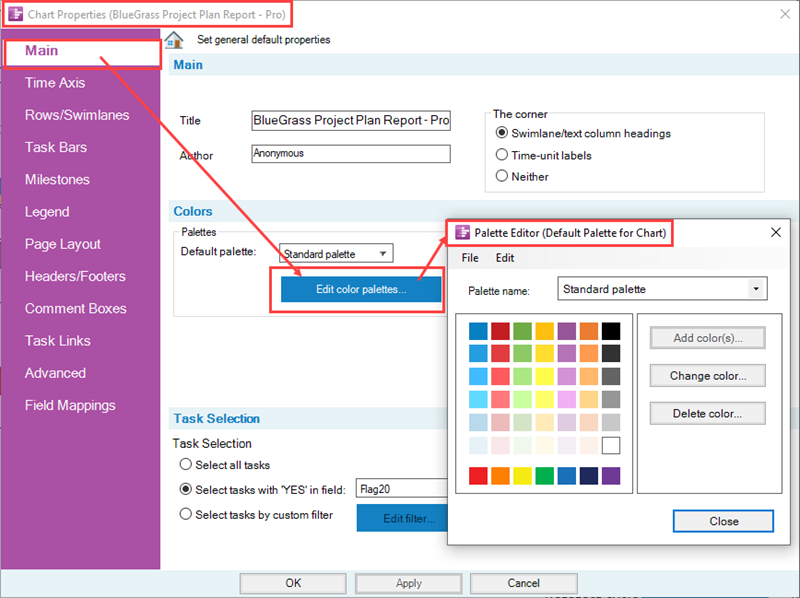
Select an existing color palette as the starting point for your custom color palette by choosing one of the color palettes from the Palette name: dropdown list:
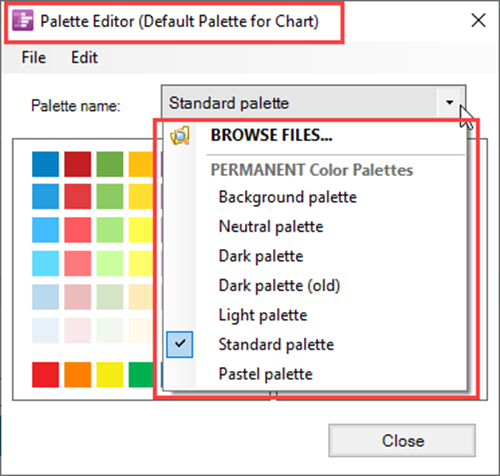
You have the option to BROWSE… the available distributed color palettes or select a color palette group from the dropdown list shown above. When you click on the BROWSE… command, OnePager accesses the Open window shown below:
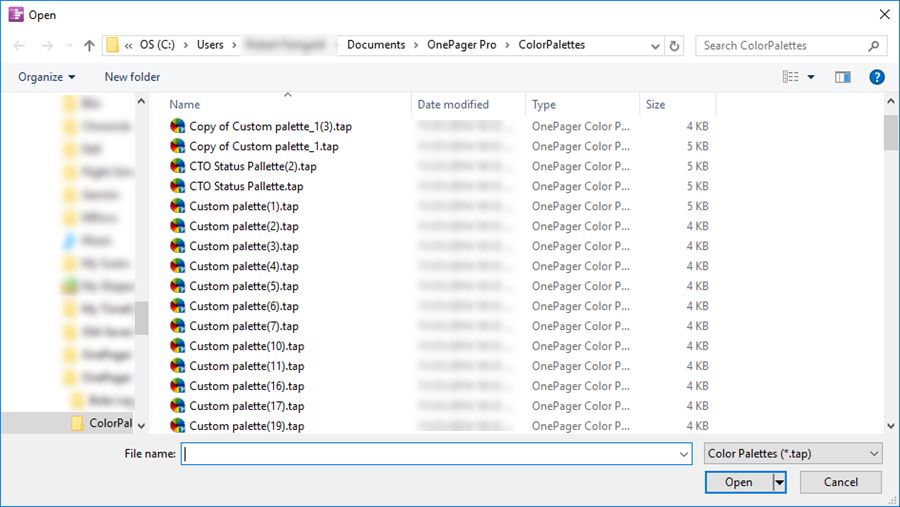
Select the desired color palette and click Open to make the selected color palette the current color palette. Clicking on any of the other options in the dropdown list above immediately makes that selected color palette the current color palette. To create the custom color palette navigate to the Palette Editor menu bar’s File button and click Save current color palette as… command, shown below:
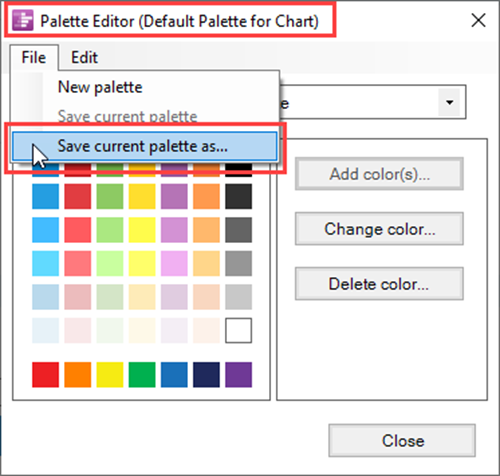
Clicking the Save current palette as… dropdown menu command accesses the Export Chronicle Graphics color palette (.TAP) file form where you can name your custom color palette and even save it in a different folder than OnePager previously created. The Export Chronicle Graphics color palette (TAP) file form looks like this:
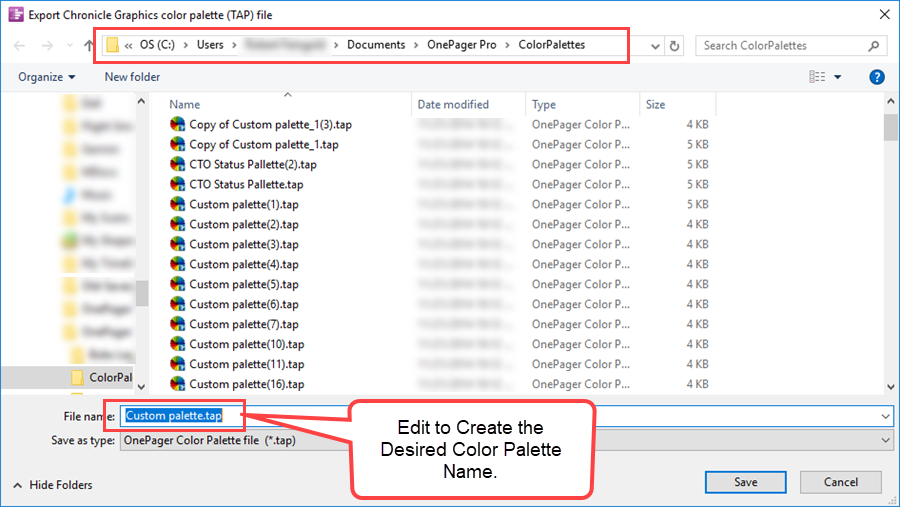
Using the same process, you can create color palettes by using the Main tab on the Template Properties form as demonstrated in the following sections.
Editing Color Palettes
You can add a color to an existing color palette, edit, or delete a color from a color palette. Before you can make edits to an existing color palette it must be retrieved from its storage folder.
To do this, launch the Template Properties form for the Template involved as discussed in the article at: Managing Templates (Portal)
Next, go to the Main tab and click the Edit color palettes… button. This accesses the current color palette as shown below:
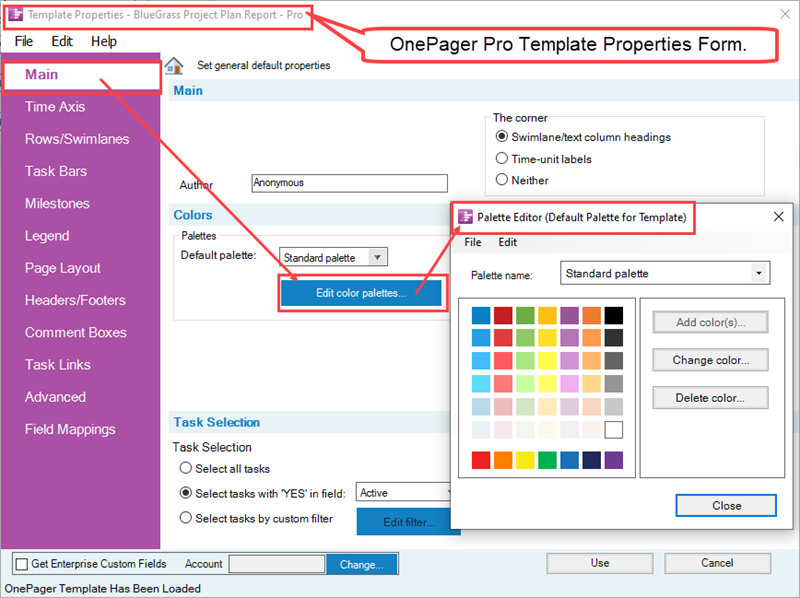
You have several areas where you can make a changes.
Edit Color Palette Name
Editing the color palette's name is done by retrieving the color palette that you want to rename using the dropdown button opposite the field named Palette name. This gives you access to all the color palettes available by providing you access to the color palette storage folder. Clicking the dropdown button reveals the following:
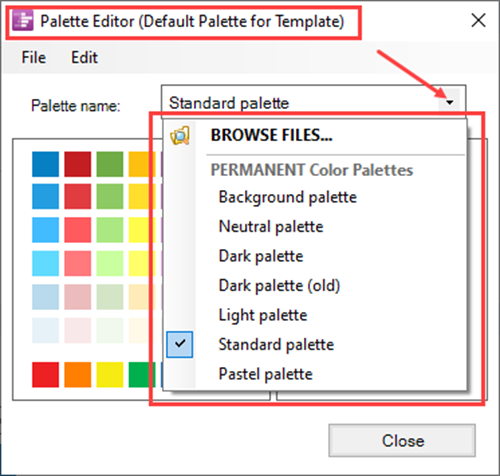
Click the BROWSE… command to access the Microsoft Windows Open form for the color palettes as shown here:
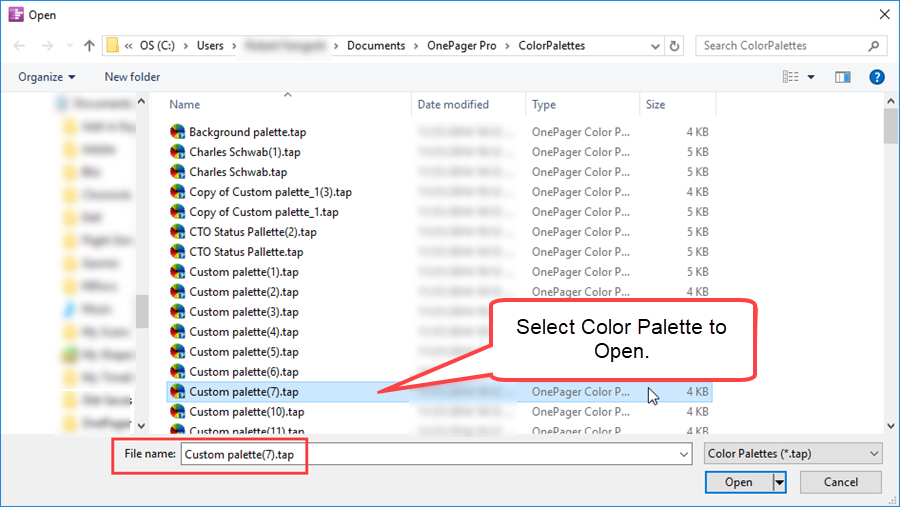
When the desired color palette is selected, click the Open button and this color palette becomes the current color palette for editing purposes. Then, click the Save current palette as… command from the File dropdown to save the renamed color palette as shown below:
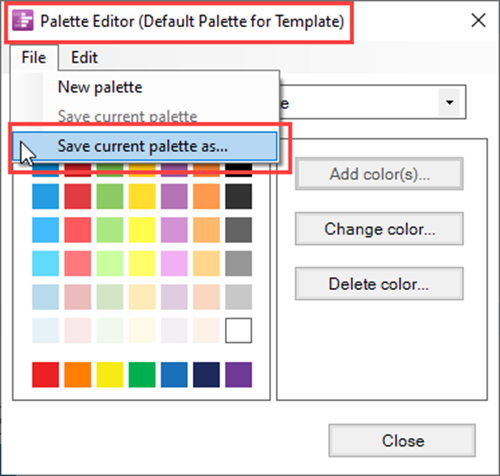
Clicking on the Save current palette as… command accesses the Export Chronicle Graphics color palette (.TAP) file form as shown below:
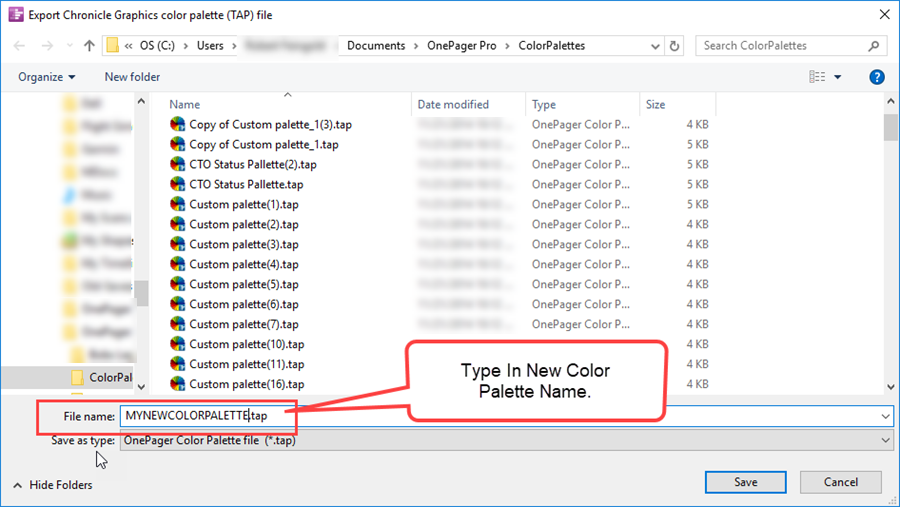
Type in the desired name for the renamed selected color palette. Click Save to save your renamed color palette. It is not recommended that you change the color palette name for any PERMANENT color palettes.
Add Colors to a Color Palette
Adding colors to a color palette is done by first accessing the Palette Editor from the Main tab of the Template Properties form and clicking the Edit button in the Palette Editor to access the dropdown command. Then click the Add color to current palette... command to access the Microsoft Windows Color form as shown below:
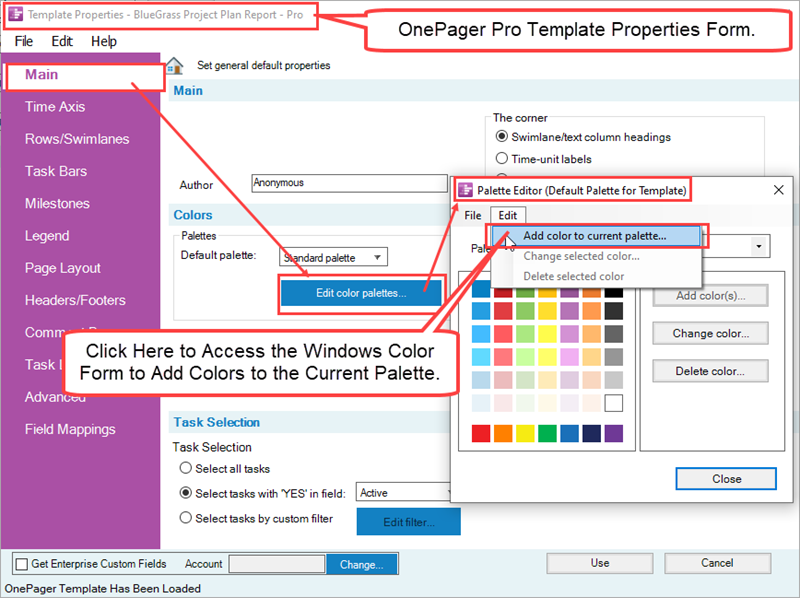
The Color form looks like this:
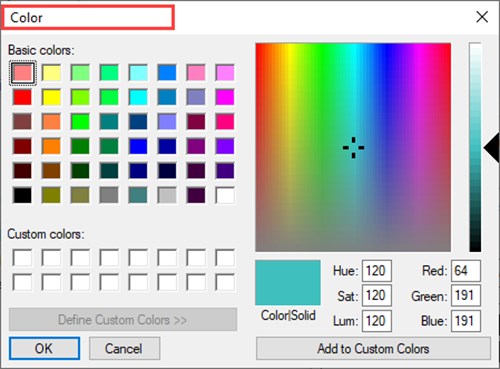
There are already basic colors selected so to add your custom colors (up to 16 at a time), place the cursor into the color spectrum area for the desired color. As this is done, the color from the color spectrum is shown in the Color|Solid window. When the desired color is showing in the Color|Solid window, click the Add to Custom Colors button. The new Custom Color is placed in the next available Custom colors: box. When this is done, the Color form looks like this:
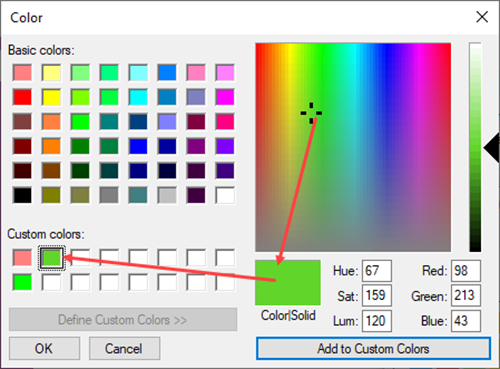
Repeat this process until all the new colors are selected. You can add up to 16 colors at a time before clicking OK to post the new colors into the color palette. At the end of the process described here the custom palette looks like this sample:
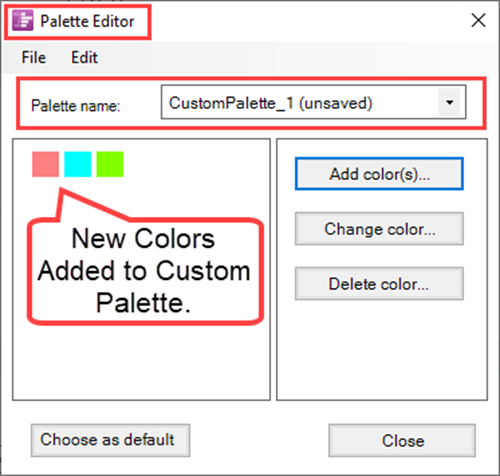
When you click the Close button the process is complete. You are then asked if you want to save the color palette that you edited as shown here.
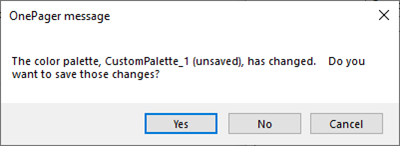
Answer Yes or No to this question and OnePager takes the appropriate action. As shown above, you have the option to cause the color palette you just edited to become the default color palette by clicking the Choose as default button. If this option is selected, in this example, Custom palette_1 becomes the default color palette for all color operations including round-robin color selection and other color related features in OnePager.
Editing Colors in a Color Palette
To change a color within a color palette, first access the desired color palette as described above so that it is visible. Now, in the Palette Editor, shown on the left in the illustration below, click the color that you want to change (1). Then click the Change color… button (2). This accesses the Color form as shown below on the right:
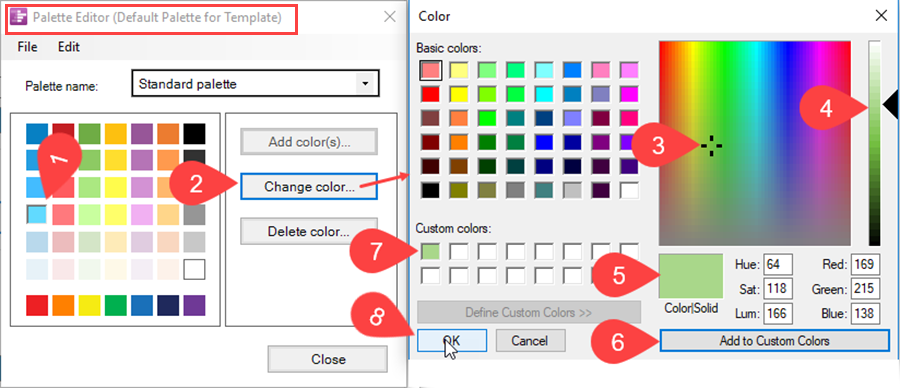
Select the new color that you want as discussed above in the Color form (3, 4, and 5). Then, click the Add to Custom Colors button (6) so that it appears in the top left-most box in the Custom colors: group on the Color form (7). Finally, click OK (8) and the changed color appears in the selected box of the Palette Editor form as shown in the sequence below:
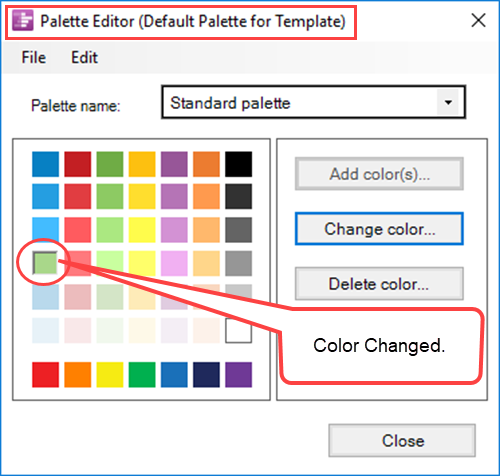
After the color is changed, click Close and the new color becomes part of the selected color palette.
Deleting a Color
To delete a color from a color palette, first access the color palette with the color you intend to delete as described above. Next, select the color box that contains the color you want to delete and click the Delete color… button as shown below:
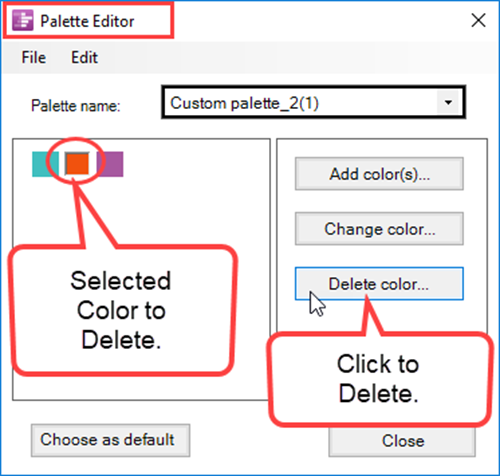
Click Close to complete the action.
Deleting a Color Palette
Since color palettes are stored the same way as charts and Template Properties forms, this means that deleting a color palette can be done by going to the folder where the color palettes are stored, selecting the correct color palette to delete, and using your keyboard's Delete Key, you can delete the selected color's file. First access the color palette file as shown below:
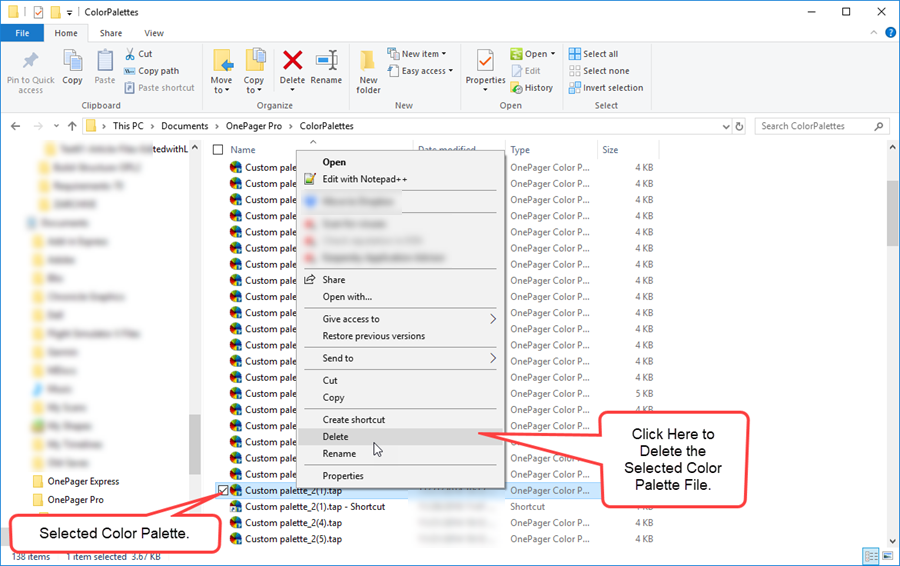
Once the color palette file for deletion is selected, click your keyboard’s Delete Key or right-click the selected file and click the Delete command in the context menu shown above.
Sharing Color Palettes
Charts are represented in your computer as a .TAM file and Template Properties forms as .TAT files. Whenever you create a chart there is a color palette associated with it and stored within the .TAM file. The same holds for named Template Properties form files (.TAT files). These color palettes are the default palette for the chart or Template Properties form in which they are stored and travel with the chart or Template Properties form where ever it might go (shared).
If you build custom color palettes or import one or more custom color palettes from elsewhere, these are stored in the ColorPalettes sub-folder under the same overall folder as your charts, Template Properties form, and custom milestone symbols. Custom color palettes are stored in .TAP files, where they are then accessible for use in the creation or update of charts. There are no special actions required to distribute a default color palette other than to export a Template Properties form or chart as discussed above.
For more information on Sharing charts, please see the article at: Sharing Charts (Portal)
When the chart or Template Properties form is imported at the destination, color palettes are stored in the ColorPalettes folder as a .TAP file and are available to select with the Edit color palettes... button in the Main tab of the Template Properties or Chart Properties forms. You can at any time access any custom color palette file (.TAP) in the ColorPalettes folder and export them in any available fashion (e.g., email attachment, etc) to any other OnePager user.
Related Links
(25.0.1-70)